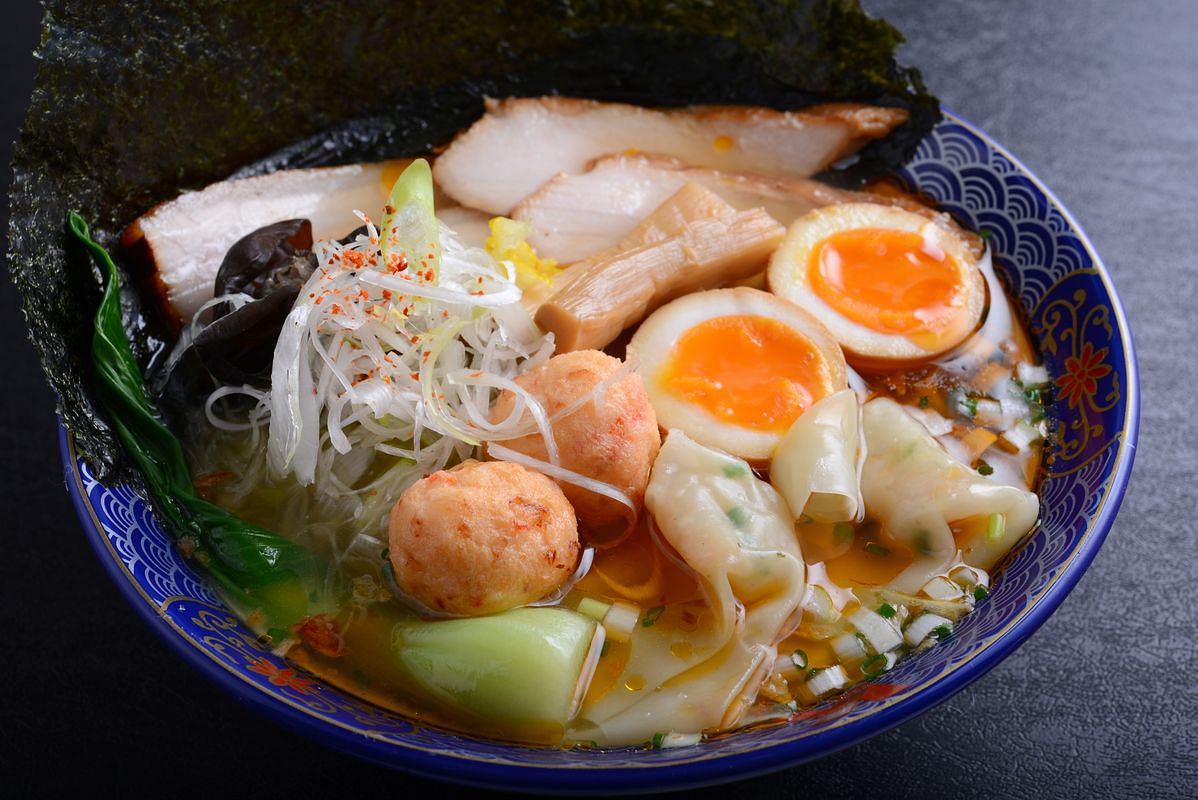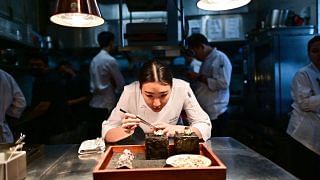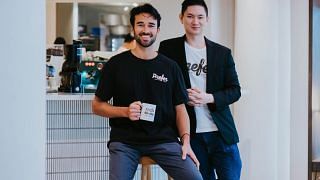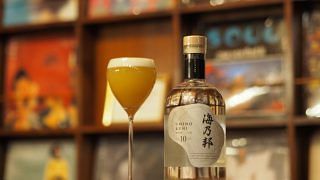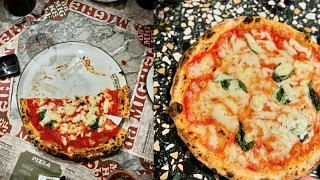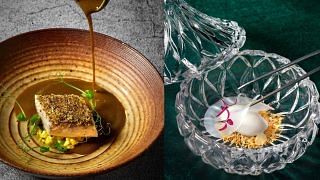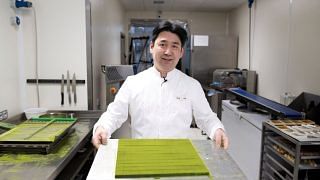These three Japanese trailblazers, who carved out profitable niche markets in Singapore, have been drawing impossibly long queues for their food products.
Keisuke Takeda, chef-founder of Keisuke Singapore
Mention ramen, full-on flavour, constant queues, and one name comes to mind: Keisuke.
Keisuke Takeda, who was crowned Ramen King at the 2011 Tokyo Ramen Championships, has been making waves in the local ramen scene since 2010. Drawing from his experience as a French chef and a Japanese chef, Keisuke is best known for his novel approach to ramen (think: lobster ramen and crab ramen).
Currently, the Keisuke group of restaurants has over 20 restaurants in Japan and 12 in Singapore. It has also expanded beyond ramen concepts. These include Ramen Keisuke Tonkotsu King (robust pork bone based soup), Ramen Keisuke Tori King (creamy chicken broth), Ginza Tendon Itsuki (assorted tempura rice bowl), and the latest addition, which sparked another queuing frenzy: Teppanyaki Hamburg Nihonbashi Keisuke Bettei, where diners can enjoy Japanese-styled hamburger steak, free-flow salad from the salad bar, and eggs galore from the a la minute egg station (they use fresh eggs from their own farm in Malaysia).
Formula for Success
“Besides a strong brand DNA: unique concepts, well-priced and delicious food, I think it is also important to be flexible and to be able to adapt to the environment,” says Takeda.
“For example, when we first opened Ramen Dining Keisuke Tokyo in the (now defunct) Parco Millenia Walk, we served ramen with prawn stock brewed from amaebi that highlighted the subtle sweetness of the prawns. This was not that popular with local diners, probably because they couldn’t help but compare the local “prawn mee” to our prawn ramen – ours was not spicy, and flavours were not as punchy. We then introduced our tonkotsu ramen, which was more flavourful and had more impact. That was very well received and queues started to form. When we opened Tonkotsu King at Orchid Hotel in 2012, the queues got longer.”
He stresses that it is also vital to understand the local market and to learn from customers’ feedback. “We received many requests from diners for ‘more oily’ or ‘less oily’, or to omit certain toppings. So we decided to incorporate that into part of the our ordering process (this is not done in ramen shops in Japan). We introduced the special form for customers to fill in to indicate their preference.” In doing so, Takeda not only allowed customers to customise their ramen, but also made it more efficient for the staff and kitchen to handle such orders.
Keisuke points out that distribution and logistics of Japanese imports have also improved greatly in Singapore in the last few years. “There are now more direct channels for chefs to get their ingredients. As a result of purchasing directly from the source, it minimises stopovers, and indirectly brings down the prices of some produce. What used to take weeks to deliver can now be flown into Singapore in a couple of days, or even the next day. So now we can get fresher ingredients to make better quality dishes for our customers,” he says.
On trends, Takeda maintains that specialisation is the way to go: “focus on certain items, and not offer everything in one restaurant.”
Teppei Yamashita, chef-founder of Teppei Group
Chef Teppei Yamashita’s highly popular unagi restaurant Man Man was listed in this year’s Singapore Michelin Guide’s Bib Gourmand list. Yamashita first came to Singapore in 2006 to work for fine dining restaurant Tenjaku. During his time here, the acute businessman saw the market potential for great value omakase sets – at the time, omakase sets were usually priced above $100. In 2011, Yamashita found a small shop in the (then) newly opened Orchid Hotel and launched Teppei Japanese Restaurant with his wife. They charged $40 to $60 for their omakase dinners. The news caught on like wild fire and during peak periods, the restaurant’s waiting list for his omakase dinner was six months long – the current wait is about a couple of weeks and omakase dinners are priced at $60 and $80.
Besides his reasonably priced omakase, Yamashita is also known for his signature bara chirashi don (the menu also lists it as kaisen don), which won diners over with its generous chunks of raw fish atop lightly vinegared rice for under $20.
The Teppei group of restaurants now include Teppei Japanese Restaurant, Hana-Hana Japanese Restaurant (which specializes in yakitori), Man Man Japanese Unagi Restaurant (which specialises in charcoal grilled eel), and Teppei Syokudo, a casual dining concept selling dons (including the bara chirashi don) and bentos, which has over six outlets in Singapore and an outlet in Wanchai, Hong Kong.
Formula for Success
Teppei maintains that hard work and “knowing what your customers like” are the most important to running a successful restaurant. “Of course, a great sense of humour and rapport does help in having diners coming back again and again,” he adds.
The case of the chirashi don is a classic example. The dish, which is prepared with cubes or slices of assorted sashimi marinated in Teppei’s special bara soy sauce, started as a daily special (higawari) on Wednesdays. It was first sold at Teppei Japanese Restaurant and over time it became so popular that customers asked for it to be made available for other days, solidifying its status as a signature dish at the restaurant. “Then an opportunity came from Takashimaya, requesting us to sell our chirashi don there,” he shares. This was the start of Teppei Syokudo.
On what’s next, he expects unagi to be the new craze. And looking at the queue at his one-year-old Man Man Japanese Unagi Restaurant, where live eel imported from Japan is prepared and grilled over charcoal daily, one sees the potential. He also sees more varieties of dons and bento sets to be popular, as more and more people having dons or bento for lunch/dinner. What else? “Onigiri for breakfast or a quick snack perhaps,” he says.
Shintaro Naganuma, founder and CEO, Bake Inc
Shintaro Naganuma’s family has been in the baking business for 30 years, specialising in European cakes and cookies. Their Hokkaido-based bakery Kinotoya specialises in chilled blueberry cheese tarts. However, during an event in Singapore some five years ago, it was the warm, unembellished cheese tarts that drew crowds.
The freshly baked cheese tarts from BAKE, with a buttery crust and molten core, took Singapore by storm when they opened their store at ION Orchard in April 2016. The snaking queue in front of the shop persisted for months, and many other bakeries started coming up with their own versions.
Launched in Sapporo, Hokkaido, in 2011, BAKE Cheese Tart has since expanded to places like Seoul, Hong Kong, Bangkok and Shanghai. The Singapore outlet is the fifth one outside of Japan. And business has been doing well. Compared to April last year, the number of cheese tarts sold has increased by at least 20 per cent. They have also opened a second outlet at Westgate in October 2016.
Formula for Success
At Bake, they take pride in their cheese tarts, which are 100 per cent made in Hokkaido with top quality ingredients. “We develop our original cream cheese, original blended flour for our tarts,” Naganuma shares. He explains that the cheese tarts sold in Singapore are imported directly from Hokkaido, which ensures consistency. The cheese tarts are then baked on-site at the shop as only freshly baked cheese tarts have the combined crunchy and fluffy texture, and the lovely aroma of cheese.
Naganuma tells us that the Bake business model is developed by just focusing on one product for each brand, at each shop, and they are constantly striving to improve their products by sourcing for better ingredients. “In my opinion, ingredients provide the top value for a product, therefore we enter the primary sector industries to develop and manufacture our ingredients together. Hence raising the value for our product.”



